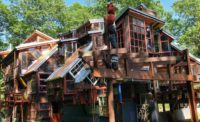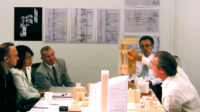Landscape architect Diana Balmori died of lung cancer on November 14 in Manhattan at the age of 84. Balmori was born in Gijón, Spain, and grew up in Tucumán, Argentina, where she studied architecture and met her husband, César Pelli. The couple migrated to the U.S. in 1952. Balmori earned a Ph.D. in urban history at UCLA and, after the two moved to the east coast, she turned to landscape design, working in Pelli’s New Haven office and teaching at Yale University. In 1990, she founded Balmori Associates and designed major landscape and urban design projects for Bilbao and Sejong, South Korea, among other places. Her longtime collaborator, architect Joel Sanders, reflects on Balmori’s contributions.
Once in a lifetime, fortune puts us in contact with an individual who changes how we see the world. For me, that person was Diana Balmori. Our first encounter was a post-lecture dinner at the Yale School of Architecture in 2002, where we both were teaching. A lively conversation evolved into an eye-opening, 14-year professional collaboration that exposed me to a new discipline— landscape—which had not been central to my way of thinking or working.
Diana possessed an expansive intelligence that allowed her to make connections across disciplines, resulting in her conception of environ- mental design as a practice shaped by the intersection of formal, technical, social, and political concerns. Although she was private by nature, I came to realize that her diverse interests and mind-set stemmed at least in part from the influence of her father, Clemente Hernando Balmori, a linguist, and her mother, Dorothy Ling, a pianist and composer, who fled the Spanish Civil War for political reasons, eventually settling in Argentina. There Diana studied architecture, but her student activism prevented her from getting her degree.
A polymath, Diana studied urban and landscape history, and worked in a variety of academic and professional contexts in the U.S. before launching her own office in New York. Her unorthodox career trajectory made her a wonderful collaborator and teacher—an agile thinker who addressed design problems from multiple perspectives and brought sustainable principles to her formally and programmatically provocative projects, which wove together people, buildings, and sites.
Diana understood that this integrated model of practice required a new way of thinking and working. Although we came from different generations and backgrounds, Diana and I shared a common bond: we were each sensitive to the way gender stereotypes shaped design approaches and professional conduct, leading to the marginalization of landscape as a practice tainted by an association with femininity and decoration. Diana bristled when she recounted the way architects invited her to “shrub up” their completed “object” buildings. She championed an inclusive design process, advocating that landscape architects be involved with a project from its inception.
I suspected that Diana’s experience as an activist and feminist motivated her to become a polemical advocate for landscape as a profession and for its own set of design principles. That, and her fierce determination and independent spirit gave her the confidence to strike out as a sole practitioner at an age when others would be contemplating retirement.
Endlessly curious, Diana continued to acquaint herself with innovative developments in art, design, science, ecology, and computation. I marveled at her acquisitive eye for the new: identifying up-and-coming designers for our co-edited book Groundwork: Between Landscape and Architecture (2011), assembling topnotch consultants for projects we pursued together, or curating itineraries for Yale studio trips to China, Japan, and India. The students and I could barely keep up with her as she navigated the crowded streets of Delhi or strolled the gardens of Suzhou.
Out of respect for Diana’s eternally youthful spirit, I resisted the temptation to Google her age, a number I never learned until her death. I am one of many who will miss her as a designer, theorist, historian, and friend.






Post a comment to this article
Report Abusive Comment